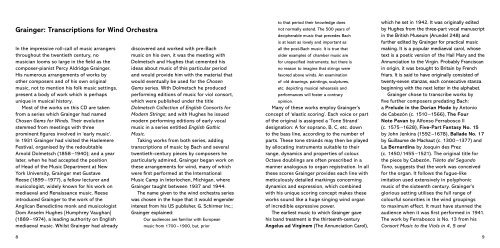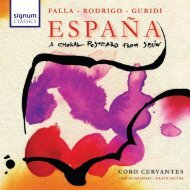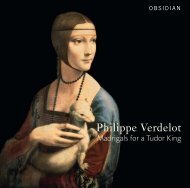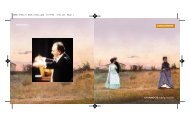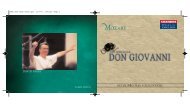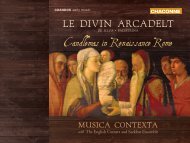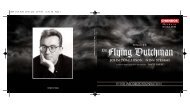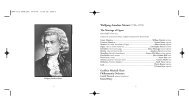You also want an ePaper? Increase the reach of your titles
YUMPU automatically turns print PDFs into web optimized ePapers that Google loves.
Grainger: Transcriptions for Wind Orchestra<br />
In the impressive roll-call of music arrangers<br />
throughout the twentieth century, no<br />
musician looms so large in the fi eld as the<br />
composer-pianist Percy Aldridge Grainger.<br />
His numerous arrangements of works by<br />
other composers and of his own original<br />
music, not to mention his folk music settings,<br />
present a body of work which is perhaps<br />
unique in musical history.<br />
Most of the works on this CD are taken<br />
from a series which Grainger had named<br />
Chosen Gems for Winds. Their evolution<br />
stemmed from meetings with three<br />
prominent fi gures involved in ‘early music’.<br />
In 1931 Grainger had visited the Haslemere<br />
Festival, organised by the redoubtable<br />
Arnold Dolmetsch (1858 –1940); and a year<br />
later, when he had accepted the position<br />
of Head of the Music Department at New<br />
York University, Grainger met Gustave<br />
Reese (1899 –1977), a fellow lecturer and<br />
musicologist, widely known for his work on<br />
mediaeval and Renaissance music. Reese<br />
introduced Grainger to the work of the<br />
Anglican Benedictine monk and musicologist<br />
Dom Anselm Hughes [Humphrey Vaughan]<br />
(1889 –1974), a leading authority on English<br />
mediaeval music. Whilst Grainger had already<br />
discovered and worked with pre-Bach<br />
music on his own, it was the meeting with<br />
Dolmetsch and Hughes that cemented his<br />
ideas about music of this particular period<br />
and would provide him with the material that<br />
would eventually be used for the Chosen<br />
Gems series. With Dolmetsch he produced<br />
performing editions of music for viol consort,<br />
which were published under the title<br />
Dolmetsch Collection of English Consorts for<br />
Modern Strings; and with Hughes he issued<br />
modern performing editions of early vocal<br />
music in a series entitled English Gothic<br />
Music.<br />
Taking works from both series, adding<br />
transcriptions of music by Bach and several<br />
twentieth-century pieces by composers he<br />
particularly admired, Grainger began work on<br />
these arrangements for wind, many of which<br />
were fi rst performed at the International<br />
Music Camp in Interlochen, Michigan, where<br />
Grainger taught between 1937 and 1944.<br />
The name given to the wind orchestra series<br />
was chosen in the hope that it would engender<br />
interest from his US publisher, G. Schirmer Inc.;<br />
Grainger explained:<br />
Our audiences are familiar with European<br />
music from 1700 –1900, but, prior<br />
to that period their knowledge does<br />
not normally extend. The 500 years of<br />
decipherable music that precedes Bach<br />
is at least as lovely and important as<br />
all the post-Bach music. It is true that<br />
older examples of chamber music are<br />
for unspecifi ed instruments; but there is<br />
no reason to imagine that strings were<br />
favored above winds. An examination<br />
of old drawings, paintings, sculptures,<br />
etc. depicting musical rehearsals and<br />
performances will foster a contrary<br />
opinion.<br />
Many of these works employ Grainger’s<br />
concept of ‘elastic scoring’. Each voice or part<br />
of the original is assigned a ‘Tone Strand’<br />
designation: A for soprano, B, C, etc. down<br />
to the bass line, according to the number of<br />
parts. These tone strands may then be played<br />
by allocating instruments suitable to their<br />
range, dynamics and properties of colour.<br />
Octave doublings are often prescribed in a<br />
manner analogous to organ registration. In all<br />
these scores Grainger provides each line with<br />
meticulously detailed markings concerning<br />
dynamics and expression, which combined<br />
with his unique scoring concept makes these<br />
works sound like a huge singing wind organ<br />
of incredible expressive power.<br />
The earliest music to which Grainger gave<br />
his band treatment is the thirteenth-century<br />
Angelus ad Virginem (The Annunciation Carol),<br />
which he set in 1942. It was originally edited<br />
by Hughes from the three-part vocal manuscript<br />
in the British Museum (Arundel 248) and<br />
further edited by Grainger for practical music<br />
making. It is a popular mediaeval carol, whose<br />
text is a poetic version of the Hail Mary and the<br />
Annunciation to the Virgin. Probably Franciscan<br />
in origin, it was brought to Britain by French<br />
friars. It is said to have originally consisted of<br />
twenty-seven stanzas, each consecutive stanza<br />
beginning with the next letter in the alphabet.<br />
Grainger chose to transcribe works by<br />
fi ve further composers predating Bach:<br />
a Prelude in the Dorian Mode by Antonio<br />
de Cabezón (c. 1510 –1566), The Four<br />
Note Pavan by Alfonso Ferrabosco II<br />
(c. 1575 –1628), Five-Part Fantasy No. 15<br />
by John Jenkins (1592–1678), Ballade No. 17<br />
by Guillaume de Machaut (c. 1300 –1377) and<br />
La Bernardina by Josquin des Prez<br />
(c. 1450/1455 –1521). The original title for<br />
the piece by Cabezón, Tiènto del Segundo<br />
Tono, suggests that the work was conceived<br />
for the organ. It follows the fugue-like<br />
imitation used extensively in polyphonic<br />
music of the sixteenth century. Grainger’s<br />
glorious setting utilises the full range of<br />
colourful sonorities in the wind groupings<br />
to maximum effect. It must have stunned the<br />
audience when it was fi rst performed in 1941.<br />
The work by Ferrabosco is No. 13 from his<br />
Consort Music to the Viols in 4, 5 and<br />
8 9<br />
<strong>CHAN</strong> <strong>10455</strong> <strong>Booklet</strong>.<strong>indd</strong> 8-9 3/2/08 11:23:40


